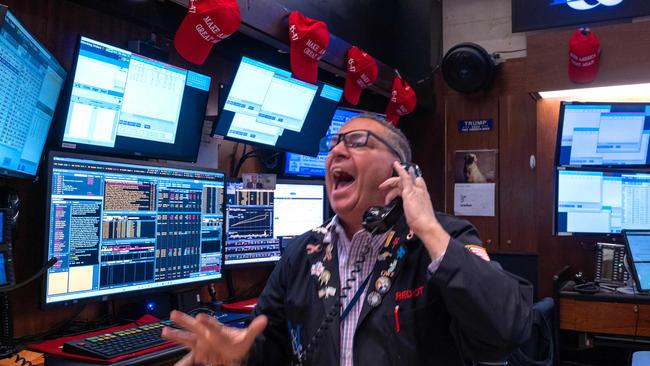ASX hits three-month low as US shutdown fear adds to worry
The ASX 200 hit a three-month low and the traditional Santa Claus rally was in doubt after the risk of a US government shutdown flared.

The traditional Santa Claus rally in stocks was in doubt after the risk of US government shutdown flared and the market proved complacent about the risk of the Fed taking the punchbowl away after surprisingly hawkish outcome from the meeting this week.
The Fed meeting was expected to be a straightforward decision to cut rates and dial back some rate cut projections for 2025. However, chair Jerome Powell made it clear that the powerful Federal Open Market Committee had shifted its priority from supporting jobs to fighting inflation..
After a 27 per cent rise in the S&P 500 and massive gains in bitcoin and AI stocks this year, it was a reminder of the Fed’s role in “taking away the punchbowl just as the party gets going”.
Will sustained US economic growth and the AI boom once again outweigh such concerns?
Powell said the dialling back of rate cut forecasts was partly due to the strength of the economy and a rebound in inflation in recent months but also due to FOMC members’ “uncertainty” about the impact of Donald Trump’s policies on inflation.
“From now, we are in a place where the risks really are balanced and we need to see progress on inflation. And that’s how we’re thinking about it,” he said.
The bar to cut rates has been raised. For the stockmarket, the so-called “Fed put” – the theoretical point at which the Fed might soften its tune to support the stockmarket – may be much lower.
The Fed’s shift in focus from supporting jobs to fighting inflation has forced markets to reassess their bullish assumption this year that the US central bank has their backs.
As if the hawkish shift in messaging on the US interest rate outlook wasn’t enough, the risk of an imminent shutdown of the US government continued to escalate before the weekend, triggering a further sell-off in Australian stocks as the US market looked set for another bruising.
After diving 1.7 per cent on Thursday, Australia’s S&P/ASX 200 share index fell as much as 1.5 per cent on Friday, hitting a three-month low of 8051.2 as nascent risk aversion in global markets made profit taking a priority for super funds sitting on massive paper profits in banks this year.
Banks are among the best performing large cap stocks this year.
However they were pummelled on Friday for no fault of their own. The majors fell 1.2 per cent to 3.7 per cent.
Perhaps unsurprisingly the sell-off was led by the world’s most expensive bank, CBA.
Positively, the index closed above its November 1 low at 8063.2, a get support level on the chart.
A clean break of that level would call for a test of major support from the 200-day moving average at 7979, a line which hasn’t been broken since the current bull market resumed in December 2023.
At the same time, this is a good level for the Santa Claus rally to start – if the US also rebounds.
S&P 500 futures fell about 0.5 per cent in Friday’s APAC trading, reversing an early rise as congress rejected a temporary funding deal backed by Donald Trump, risking a government shutdown. Trump and his key adviser Elon Musk had pressured GOP lawmakers to abandon an earlier bipartisan deal, with Trump insisting Republican leaders add a provision waiving or raising the federal debt limit before he takes office.
However, the bill failed by a vote of 235 to 174, with 38 Republicans and nearly all Democrats voting against the spending package, which would have also suspended the debt ceiling for two years.
It came after a disappointing night on Wall Street. After tumbling 3 per cent after the US rate decision on Wednesday, the S&P 500 was unable to hold on to its intraday rise on Thursday.
The VIX index of S&P 500 options volatility cooled somewhat, but remained dangerously high at 24.09 per cent, versus its long-term average of 19.44 per cent.
Pepperstone’s head of research, Chris Weston, said many were questioning whether a seasonal rally in the US and other developed markets stocks was still a possibility after the sell-off.
Based on his analysis of the daily returns of the S&P 500 for the past 15 years, the average start date for the Santa Claus rally has been the end of the current week.
But in light of diminishing hopes of US rate cuts but ongoing strength in the US economy, a more important issue will be whether investors buy or sell into any such rally. In 2024, economic growth and the AI boom trumped worries about the timing and magnitude of rate cuts.





